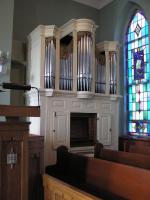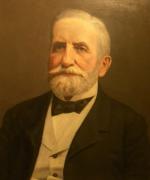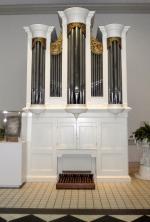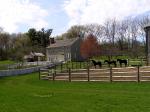![header=[Marker Text] body=[One of America's foremost pipe-organ builders. Tannenberg, born at Berthelsdorf, Germany, emigrated to the Moravian community at Bethlehem in 1749. From 1760-1765 he lived at Burnside Plantation, where he built organs as an apprentice of Johann Gottlob Klemm (1690-1762), then moved to Lititz. Tannenberg died while working in York, Pa. His nearly 50 instruments represent the finest tonal and visual artistry among early American pipe organ builders.] sign](http://explorepahistory.com/kora/files/1/10/1-A-3CD-139-ExplorePAHistory-a0n2c8-a_450.jpg)
Mouse over for marker text
Name:
David Tannenberg (1728-1804)
Region:
Philadelphia and its Countryside/Lehigh Valley
County:
Northampton
Marker Location:
1461 Schoenersville Rd., at entrance to Burnside Plantation, Bethlehem
Dedication Date:
June 9, 1923
Behind the Marker
All newcomers to Pennsylvania brought their music with them: their love songs and work songs, ballads and chants, religious music and folk songs, all with their own distinctive rhythms, melodies, and harmonies. These mixed and merged in the Commonwealth and elsewhere in the Americas giving rise to new forms of distinctly American music. In the 1730s Conrad Beissel devised his own system of composition for the writing of acapella hymns sung and then published in 1747 by the brothers and sisters of the Ephrata Cloister near Lancaster. In the early 1800s, the
Ephrata Cloister near Lancaster. In the early 1800s, the  Harmonists in Economy supported one of the first symphony orchestras west of the Alleghenies. In early Pennsylvania, however, no group was better known for its music than the Moravians of the Lehigh Valley.
Harmonists in Economy supported one of the first symphony orchestras west of the Alleghenies. In early Pennsylvania, however, no group was better known for its music than the Moravians of the Lehigh Valley.
Music was an essential part of Moravian social gatherings, celebrations, and religious worship.The Moravians were famous for their trombone choirs, instrumental music, and vocal choruses. Count Nicholas Ludwig von Zinzendorf, who established the first Moravian settlements in the Lehigh Valley in the 1740s, understood how singing engaged the active participation of the congregation in worship. The Moravian "Singstunde" or song service, required the pastor to sing his sermon, which required the organist to memorize hundreds of songs-and to play them in the appropriate key. Moravians consequently became prolific composers of hymns. In 1778, Christian Gregor (1723-1801) compiled a hymnbook that contained 1,750 hymns, more than 300 written by Gregor himself.
The playing of hymns required the construction of church organs. Between the 1760s and his death in 1804, David Tannenberg of Lititz built and supervised the installation of nearly fifty instruments of his own design in churches throughout the Commonwealth.
Lititz built and supervised the installation of nearly fifty instruments of his own design in churches throughout the Commonwealth.
Born in Berthelsdorf, Upper Lusatia, Germany on March 21, 1728, Tannenberg as a child came under the influence and patronage of Count Zinzendorf at the Moravian village of Herrnhut, who saw that he received proper schooling, including musical training.A year after joining the Moravian community in Zeist, Holland, in 1749, Tannenberg accompanied fellow Pietists to America and settled in Bethlehem, Pennsylvania. That summer, he and Anna Rosina Kern were married along with twenty-seven other couples in an arranged-marriage ceremony that has since come to be known as the "Great Wedding."
After nearly a decade in the building trade, the thirty-one-year-old Tannenberg in 1758 began an apprenticeship as an organ builder with Johann Gottlob Clemm (a.s.a. Klemm). Over the next four years, until Clemm's death in 1762, the master and his pupil built no fewer than five organs for Moravian chapels throughout eastern Pennsylvania.
By 1765, Tannenberg had moved his family to the Moravian settlement at Lititz, Lancaster County, and commenced his own highly successful organ making business. Tannenberg resided in Lititz for the rest of his life, actively participating in community affairs and serving as a kind of musical director in the borough's Moravian chapel. There, Tannenberg played the organ and violin, and served as a cantor and member of the chorus.
Like other Pennsylvania colonists, Moravians maintained contact with their relatives and colleagues in Europe. The Moravians were great lovers of the great instrumental music of Europe. By the late 1700s, Collegia musica in Bethlehem, Lititz, and Nazareth were playing the music of the Bachs, Haydn, and many lesser-known composers, whose works they copied and mimicked in their own compositions. (Each May, thousands of visitors from the United States and abroad continue to come to Bethlehem for the annual Bach Festival, founded by Moravian conductor John Frederick Wolle in 1900.) Tannenberg relied on manuals and treatise from Germany to build and fine-tune his pipe organs.
Nazareth were playing the music of the Bachs, Haydn, and many lesser-known composers, whose works they copied and mimicked in their own compositions. (Each May, thousands of visitors from the United States and abroad continue to come to Bethlehem for the annual Bach Festival, founded by Moravian conductor John Frederick Wolle in 1900.) Tannenberg relied on manuals and treatise from Germany to build and fine-tune his pipe organs.
Over the next four decades Tannenberg supervised the installation of scores of organs in Moravian and German Lutheran churches around the Commonwealth. As his health permitted, he also traveled to Moravian communities as far away as Virginia and North Carolina. In his later years Tannenberg sent to Europe for an assistant and secured the services of John Philip Bachmann. Thirty years old when he arrived in Lititz in 1793, Bachman helped Tannenberg build and install more than a dozen organs over the next ten years. While installing an organ at Christ Lutheran Church in York, Tannenberg suffered a massive stroke on May 17, 1804, and died two days later.
The Christ Church organ was played for the first time at Tannenberg's funeral service on May 21. As he was laid to rest a children's choir from both Lutheran and Moravian churches sang hymns next to his grave in York's God's Acre, the name Moravians gave to all of their cemeteries in both Europe and the New World.
More than two centuries after his death, David Tannenberg is revered in church music circles. In the 1800s his disciples continued to build organs according to his design concepts. Fewer than a dozen Tannenberg organs have survived. Today, his 1804 Christ Church organ is housed with the York Historical Trust in York, Pennsylvania.
Music was an essential part of Moravian social gatherings, celebrations, and religious worship.The Moravians were famous for their trombone choirs, instrumental music, and vocal choruses. Count Nicholas Ludwig von Zinzendorf, who established the first Moravian settlements in the Lehigh Valley in the 1740s, understood how singing engaged the active participation of the congregation in worship. The Moravian "Singstunde" or song service, required the pastor to sing his sermon, which required the organist to memorize hundreds of songs-and to play them in the appropriate key. Moravians consequently became prolific composers of hymns. In 1778, Christian Gregor (1723-1801) compiled a hymnbook that contained 1,750 hymns, more than 300 written by Gregor himself.
The playing of hymns required the construction of church organs. Between the 1760s and his death in 1804, David Tannenberg of
Born in Berthelsdorf, Upper Lusatia, Germany on March 21, 1728, Tannenberg as a child came under the influence and patronage of Count Zinzendorf at the Moravian village of Herrnhut, who saw that he received proper schooling, including musical training.A year after joining the Moravian community in Zeist, Holland, in 1749, Tannenberg accompanied fellow Pietists to America and settled in Bethlehem, Pennsylvania. That summer, he and Anna Rosina Kern were married along with twenty-seven other couples in an arranged-marriage ceremony that has since come to be known as the "Great Wedding."
After nearly a decade in the building trade, the thirty-one-year-old Tannenberg in 1758 began an apprenticeship as an organ builder with Johann Gottlob Clemm (a.s.a. Klemm). Over the next four years, until Clemm's death in 1762, the master and his pupil built no fewer than five organs for Moravian chapels throughout eastern Pennsylvania.
By 1765, Tannenberg had moved his family to the Moravian settlement at Lititz, Lancaster County, and commenced his own highly successful organ making business. Tannenberg resided in Lititz for the rest of his life, actively participating in community affairs and serving as a kind of musical director in the borough's Moravian chapel. There, Tannenberg played the organ and violin, and served as a cantor and member of the chorus.
Like other Pennsylvania colonists, Moravians maintained contact with their relatives and colleagues in Europe. The Moravians were great lovers of the great instrumental music of Europe. By the late 1700s, Collegia musica in Bethlehem, Lititz, and
Over the next four decades Tannenberg supervised the installation of scores of organs in Moravian and German Lutheran churches around the Commonwealth. As his health permitted, he also traveled to Moravian communities as far away as Virginia and North Carolina. In his later years Tannenberg sent to Europe for an assistant and secured the services of John Philip Bachmann. Thirty years old when he arrived in Lititz in 1793, Bachman helped Tannenberg build and install more than a dozen organs over the next ten years. While installing an organ at Christ Lutheran Church in York, Tannenberg suffered a massive stroke on May 17, 1804, and died two days later.
The Christ Church organ was played for the first time at Tannenberg's funeral service on May 21. As he was laid to rest a children's choir from both Lutheran and Moravian churches sang hymns next to his grave in York's God's Acre, the name Moravians gave to all of their cemeteries in both Europe and the New World.
More than two centuries after his death, David Tannenberg is revered in church music circles. In the 1800s his disciples continued to build organs according to his design concepts. Fewer than a dozen Tannenberg organs have survived. Today, his 1804 Christ Church organ is housed with the York Historical Trust in York, Pennsylvania.










